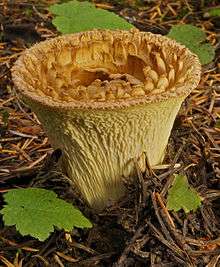Turbinellus kauffmanii
| Turbinellus kauffmanii | |
|---|---|
 | |
| Scientific classification | |
| Kingdom: | Fungi |
| Division: | Basidiomycota |
| Class: | Agaricomycetes |
| Order: | Gomphales |
| Family: | Gomphaceae |
| Genus: | Turbinellus |
| Species: | T. kauffmanii |
| Binomial name | |
| Turbinellus kauffmanii (A.H.Sm.) Giachini (2011) | |
| Synonyms | |
| |
Turbinellus kauffmanii, previously known as Gomphus kauffmanii, is a mushroom native to North America.[1]
It was described in 1947 as Cantharellus kauffmanii by Alexander H. Smith, who treated the members of Gomphus as two sections—Gomphus and Excavatus—within Cantharellus in his 1947 review of chanterelles in western North America, as he felt there were no consistent characteristics that distinguished the genera. T. kauffmanii was placed in the latter section due to its scaly cap, lack of clamp connections and rusty spores.[2] E. J. H. Corner placed it in the genus Gomphus in 1966.[3] The genus Gomphus, along with several others in the Gomphaceae, was reorganized in the 2010s after molecular analysis confirmed that the older morphology-based classification did not accurately represent phylogenetic relationships.[1][4][5] Thus, Turbinellus floccosus was made the type species of the genus Turbinellus.[1]
The cap is generally 10–20 cm (4–8 in) in diameter, though rarely can be up to 35 cm (14 in) across.[2] The cap is olive to brown, with the surface splitting into olive- to clay-coloured scales as it ages, with white flesh between. The overall shape of the fruitbody is vase-shaped. The flesh is thick and white. The spore-bearing surface is yellow when young and ages to a buff-pink, and stains wine-coloured when bruised in younger specimens. The hymenium is decurrently attached to the stipe. The stipe is generally 8–15 cm (3–6 in) high and 2–4 cm (3⁄4–1 1⁄2 in) wide, though can be as tall as 40 cm (15 1⁄2 in). The spore print is ochre-coloured. Younger specimens also have a pungent smell,[2] and the flesh can have an acrid taste.[6]
Turbinellus kauffmanii is native to the Pacific Northwest and northern California,[6] where it is found in coniferous forests on soil rich in humus, with fruitbodies more common in warm wet summers.[2] It has also been recorded from Amanalco municipality in central Mexico.[7]
Laboratory experiments have shown that T. kauffmanii contains norcaperatic acid, though at lower concentrations than T. floccosus.[8] Norcaperatic acid increases tone of guinea pig smooth muscle of the small bowel (ileum), and that when given to rats, leads to mydriasis, skeletal muscle weakness, and central nervous system depression. It is likely the agent responsible for toxic (gastrointestinal) symptoms that occur in T. floccosus.[9]
References
- 1 2 3 Giachini AJ, Castellano MA (2011). "A new taxonomic classification for species in Gomphus sensu lato". Mycotaxon. 115: 183–201. doi:10.5248/115.183.
- 1 2 3 4 Smith AH, Morse EE (1947). "The Genus Cantharellus in the Western United States". Mycologia. 39 (5): 497–534 [517–18]. doi:10.2307/3755192. JSTOR 3755192.
- ↑ Corner EJH (1966). "A Monograph of Cantharelloid Fungi". Annals of Botany Memoirs. 2. Oxford University Press: 122.
- ↑ Giachini AJ, Hosaka K, Nouhra E, Spatafora J, Trappe JM (2010). "Phylogenetic relationships of the Gomphales based on nuc-25S-rDNA, mit-12S-rDNA, and mit-atp6-DNA combined sequences". Fungal Biology. 114 (2–3): 224–34. doi:10.1016/j.funbio.2010.01.002. PMID 20943133.
- ↑ Giachini AJ, Camelini CM, Rossi MJ, Soares CRFS, Trappe JM (2012). "Systematics of the Gomphales: the genus Gomphus sensu stricto". Mycotaxon. 120: 385–400. doi:10.5248/120.385.
- 1 2 "Gomphus kauffmanii (Smith) Petersen" (PDF). Retrieved 13 November 2015.
- ↑ Burrola-Aguilar C, Garibay-Orijel R, Argüelles-Moyao A (2013). "Abies religiosa forests harbor the highest species density and sporocarp productivity of wild edible mushrooms among five different vegetation types in a neotropical temperate forest region". Agroforestry Systems. 87 (5): 1101–15. doi:10.1007/s10457-013-9623-z.
- ↑ Henry ED, Sullivan G (1969). "Phytochemical evaluation of some cantharelloid fungi". Journal of Pharmaceutical Sciences. 58 (12): 1497–1500. doi:10.1002/jps.2600581216.
- ↑ Carrano RA, Malone MH (1967). "Pharmacologic study of norcaperatic and agaricic acids". Journal of Pharmaceutical Sciences. 56 (12): 1611–14. doi:10.1002/jps.2600561216.